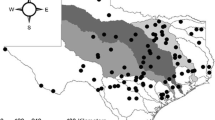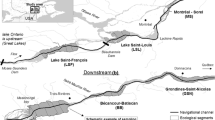Abstract
Communities can be structured over time by deterministic, stochastic, or both mechanisms. This study evaluated whether the fish assemblages of the Upper Paraná River floodplain were spatio-temporally structured and examined the mechanisms driving these organizational patterns. The floodplain ichthyofauna was sampled quarterly with seines and gillnets. The structure of the assemblage was assessed using the C-Score co-occurrence index and null models. The influence of both the environment (physical and chemical variables and hydrometric levels) and time on the species’ organization patterns was assessed via principal component analysis, multiple and simple regressions, and analyses of variance. Assemblages with larger species showed patterns of species segregation at both spatial and temporal scales, while those composed of smaller species often exhibited random patterns. The physical and chemical variables did not predict co-occurrence among species. For assemblages of large species, the patterns of co-occurrence tended to be random when the river level increased but only during high-water months. Therefore, the life history traits of the species, such as body size, may predict the structure of the assemblages in floodplains, but this effect depends on variations in the hydrometric level.




Similar content being viewed by others
References
Agostinho, A. A., L. C. Gomes, S. M. Thomaz & N. S. Hahn, 2004a. The upper Paraná river and its floodplain: main characteristics and perspectives for management and conservation. In Thomaz, S. M., A. A. Agostinho & N. S. Hahn (eds), The Upper Paraná River and Its Floodplain: Physical Aspects, Ecology and Conservation. Backhuys Publishers, Leiden: 381–393.
Agostinho, A. A., L. C. Gomes, S. Veríssimo & E. K. Okada, 2004b. Flood regime, dam regulation and fish in the Upper Paraná River: effects on assemblage attributes, reproduction and recruitment. Reviews in Fish Biology and Fisheries 14: 11–19.
Agostinho, A. A., F. M. Pelicice, A. C. Petry, L. C. Gomes & H. F. Júlio Jr, 2007. Fish diversity in the upper Paraná River basin: habitats, fisheries, management and conservation. Aquatic Ecosystem Health and Management 10: 174–186.
Arrington, D. A., K. O. Winemiller & C. A. Layman, 2005. Community assembly at the patch scale in a species rich tropical river. Oecologia 144: 157–167.
Bhat, A. & A. E. Magurran, 2007. Does disturbance affect the structure of tropical fish assemblages? A test using null models. Journal of Fish Biology 70: 623–629.
Boschilia, S. M., E. F. Oliveira & S. M. Thomaz, 2008. Do aquatic macrophytes co-occur randomly? An analysis of null models in a tropical floodplain. Oecologia 156: 203–214.
Boschilia, S. M., E. F. Oliveira & A. Schwarzbold, 2012. The immediate and long-term effects of water drawdown on macrophyte assemblages in a large subtropical reservoir. Freshwater Biology 57: 2641–2651.
Both, C., A. S. Melo, S. Z. Cechin & S. M. Hartz, 2011. Tadpole co-occurrence in ponds: when do guilds and time matter? Acta Oecologica 37: 140–145.
Caruso, T., Y. Chan, D. C. Lacap, M. C. Y. Lau, C. P. McKay & S. B. Pointing, 2011. Stochastic and deterministic processes interact in the assembly of desert microbial communities on a global scale. The ISME Journal 5: 1406–1413.
Diamond, J. M., 1975. Assembly of species communities. In Cody, M. L. & J. M. Diamond (eds), Ecology and Evolution of Communities. Harvard University Press, Cambridge: 342–444.
Douglas, M. E., P. C. Marsh & W. L. Minckley, 1994. Indigenous fishes of western north America and the hypothesis of competitive displacement: Meda fulgida (Cyprinidae) as a case study. Copeia 1994: 9–19.
Englund, G., F. Johansson, P. Olofsson, J. Salonsaari & J. Öhman, 2009. Predation leads to assembly rules in fragmented fish communities. Ecology Letters 12: 663–671.
Fernandes, R., L. C. Gomes, F. M. Pelicice & A. A. Agostinho, 2009. Temporal organization of fish assemblages in floodplain lagoons: the role of hydrological connectivity. Environmental Biology of Fishes 85: 99–108.
Gilpin, M. E. & J. M. Diamond, 1982. Factors contributing to non-randomness in species co-occurrences on islands. Oecologia 52: 75–84.
Gotelli, N. J., 2000. Null model analysis of species co-occurrence patterns. Ecology 81: 2606–2621.
Gotelli, N. J. & D. J. McCabe, 2002. Species co-occurrence: a meta-analysis of J. T. Diamond’s assembly rules model. Ecology 83: 2091–2096.
Gotelli, N. J. & B. J. McGill, 2006. Null versus neutral models: what’s the difference? Ecography 29: 793–800.
Grossman, G. D., R. E. Ratajczak Jr, M. Crawford & M. C. Freeman, 1998. Assemblage organization in stream fishes: effects of environmental variation and interspecific interactions. Ecological Monographs 68: 395–420.
Heino, J. & M. Grönroos, 2013. Does environmental heterogeneity affect species co-occurrence in ecological guilds across stream macroinvertebrate metacommunities? Ecography 36: 926–936.
Hoeinghaus, D. J., K. O. Winemiller & J. S. Birnbaum, 2007. Local and regional determinants of stream fish assemblage structure: inferences based on taxonomic vs. functional groups. Journal of Biogeography 34: 324–338.
Horner-Devine, M. C., J. M. Silver, M. A. Leibold, B. J. M. Bohannan, R. K. Colwell, J. A. Fuhrman, J. L. Green, C. R. Kuske, J. B. H. Martiny, G. Muyzer, L. Øvreås, A.-L. Reysenbach & V. H. Smith, 2007. A comparison of taxon co-occurrence patterns for macro- and microorganisms. Ecology 88: 1345–1353.
Jackson, D. A., 1993. Stopping rules in principal component analysis: a comparison of heuristical and statistical approaches. Ecology 74: 2204–2214.
Krasnov, B. R., S. Pilosof, M. Stanko, S. Morand, N. P. Korallo-Vinarskaya, M. V. Vinarski & R. Poulin, 2014. Co-occurrence and phylogenetic distance in communities of mammalian ectoparasites: limiting similarity versus environmental filtering. Oikos 123: 63–70.
Lehsten, V. & P. Harmand, 2006. Null models for species co-occurrence patterns: assessing bias and minimum iteration number for the sequential swap. Ecography 29: 786–792.
MacArthur, R. & R. Levins, 1967. The limiting similarity, convergence, and divergence of coexisting species. The American Naturalist 101: 377–385.
Matthews, W. J., 1998. Patterns in Freshwater Fish Ecology. Kluwer Academic Publishers, Norwell.
McCreadie, J. W. & C. R. Bedwell, 2013. Patterns of co-occurrence of stream insects and an examination of a causal mechanism: ecological checkerboard or habitat checkerboard? Insect Conservation and Diversity 6: 105–113.
Mouchet, M. A., M. D. M. Burns, A. M. Garcia, J. P. Vieira & D. Mouillot, 2013. Invariant scaling relationship between functional dissimilarity and co-occurrence in fish assemblages of the Patos Lagoon estuary (Brazil): environmental filtering consistently overshadows competitive exclusion. Oikos 122: 247–257.
Oksanen, J., F. G. Blanchet, R. Kindt, P. Legendre, P. R. Minchin, R. B. O’Hara, G. L. Simpson, P. Solymos, M. H. H. Stevens & H. Wagner, 2013. vegan: Community Ecology Package. R package version 2.0-7. http://CRAN.R-project.org/package=vegan
Olin, M. & T. Malinen, 2003. Comparison of gillnet and trawl in diurnal fish community sampling. Hydrobiologia 506–509: 443–449.
Oliveira, E. F., E. A. Luiz, A. A. Agostinho & E. Benedito-Cecílio, 2001. Fish assemblages in littoral areas of the upper Paraná river floodplain, Brazil. Acta Scientiarum (Biological Sciences) 23: 369–376.
Oliveira, E. F., C. V. Minte-Vera & E. Goulart, 2005. Structure of fish assemblages along spatial gradients in a deep subtropical reservoir (Itaipu Reservoir, Brazil–Paraguay border). Environmental Biology of Fishes 72: 283–304.
Piana, P. A., L. C. Gomes & A. A. Agostinho, 2006. Comparison of predator–prey interaction models for fish assemblages from the neotropical region. Ecological Modelling 192: 259–270.
Presley, S. J., 2011. Interspecific aggregation of ectoparasites on bats: importance of hosts as habitats supersedes interspecific interactions. Oikos 120: 832–841.
R Core Team, 2013. R: A Language and Environment for Statistical Computing. R Foundation for Statistical Computing, Vienna. http://www.R-project.org/.
Ruhí, A., E. Chappuis, D. Escoriza, M. Jover, J. Sala, D. Boix, S. Gascón & E. Gacia, 2014. Environmental filtering determines community patterns in temporary wetlands: a multi-taxon approach. Hydrobiologia 723: 25–39.
Sanders, N. J., N. J. Gotelli, N. E. Heller & D. M. Gordon, 2003. Community disassembly by an invasive species. Proceedings of the National Academy of Science of the United States of America 100: 2474–2477.
Souza Filho, E. E., 2009. Evaluation of the Upper Paraná River discharge controlled by reservoirs. Brazilian Journal of Biology 69: 707–716.
Stone, L. & A. Roberts, 1990. The checkerboard score and species distributions. Oecologia 85: 74–79.
Suzuki, H. I., F. M. Pelicice, E. A. Luiz, J. D. Latini & A. A. Agostinho, 2004. Reproductive strategies of the fish community of the Upper Paraná river floodplain. In Agostinho, A. A., L. Rodrigues, L. Gomes, S. M. Thomaz & L. E. Miranda (eds), Structure and Functioning of the Paraná River and Its Floodplain: LTER – site 6 – (PELD sítio 6). EDUEM, Maringá: 125–130.
Suzuki, H. I., A. A. Agostinho, D. Bailly, M. F. Gimenes, H. F. Júlio Jr & L. C. Gomes, 2009. Inter-annual variations in the abundance of young-of-the-year of migratory fishes in the Upper Paraná River floodplain: relations with hydrographic attributes. Brazilian Journal of Biology 69: 649–660.
Thomaz, S. M., L. M. Bini & R. L. Bozelli, 2007. Floods increase similarity among aquatic habitats in river-floodplain systems. Hydrobiologia 579: 1–13.
Ulrich, W., 2004. Species co-occurrences and neutral models: reassessing J. M. Diamond’s assembly rules. Oikos 107: 603–609.
Acknowledgements
We acknowledge the Nupélia for conducting the PELD program and providing the best possible environment for this study. We also thank Luiz C. Gomes, Almir M. Cunico, Sybelle Bellay, and Ángela L. Gutiérrez Cortés for comments on an early version of the manuscript, Jaime L. L. Pereira for drawing Fig. 1 and Maria C. Roberto for sampling, analyzing, and sharing the physical and chemical data. We are grateful to the Conselho Nacional de Desenvolvimento Científico e Tecnológico (CNPq; PELD site-6) for providing funding; in addition, J. C. G. Ortega thanks the Coordenação de Aperfeiçoamento de Pessoal de Nível Superior (CAPES) for a scholarship and the Programa de Excelência Acadêmica (Proex/CAPES) for additional funding, and E. F. Oliveira is also grateful to DIRPPG/UTFPR-Londrina for funding. A. A. Agostinho is continuously supported by CNPq.
Author information
Authors and Affiliations
Corresponding author
Additional information
Handling editor: Alison King
Electronic supplementary material
Below is the link to the electronic supplementary material.
Rights and permissions
About this article
Cite this article
Ortega, J.C.G., Dias, R.M., Petry, A.C. et al. Spatio-temporal organization patterns in the fish assemblages of a Neotropical floodplain. Hydrobiologia 745, 31–41 (2015). https://doi.org/10.1007/s10750-014-2089-9
Received:
Revised:
Accepted:
Published:
Issue Date:
DOI: https://doi.org/10.1007/s10750-014-2089-9




